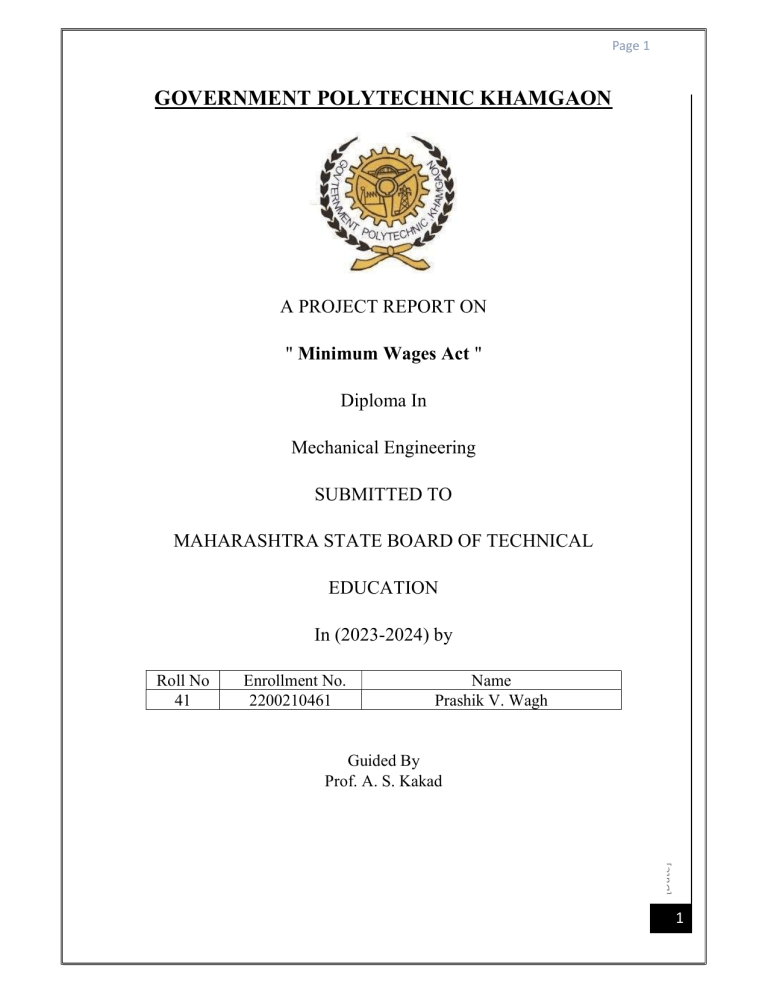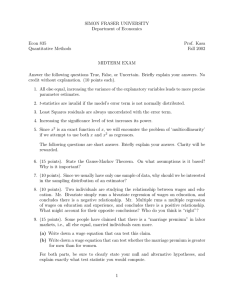
Page 1 GOVERNMENT POLYTECHNIC KHAMGAON A PROJECT REPORT ON " Minimum Wages Act " Diploma In Mechanical Engineering SUBMITTED TO MAHARASHTRA STATE BOARD OF TECHNICAL EDUCATION In (2023-2024) by Enrollment No. 2200210461 Name Prashik V. Wagh Guided By Prof. A. S. Kakad [Date] Roll No 41 1 Page 2 GOVERNMENT POLYTECHNIK, KHAMGAON CERTIFIFACET This is to Certify that Prashik V. Wagh successfully completed project report on “Minimum Wages Act ” by Student of V semester Diploma in Mechanical engineering in partial fulfillment of the requirements for the award of the Diploma in Mechanical engineering of Government Polytechnic Khamgaon during a period for the academic year 2023-24 as per curriculum. Dr. A. E. Dhole (Head of Department) Dr. S. S. Prabhune (Principal) [Date] Prof. A.S. Kakad (Guide) 2 Page 3 Introduction :The Minimum Wages Act, 1948 is a crucial labour law in India that aims to safeguard the interests of laborers by ensuring they receive fair wages for their work. This report provides an overview of the Minimum Wages Act, its objectives, key provisions, impact, challenges, and potential improvements. Objectives of the Act :The primary objectives of the Minimum Wages Act are as follows: a. To fix and revise minimum wage rates for different categories of workers. b. To prevent exploitation of labor and to promote decent living conditions. c. To address wage inequality and provide a reasonable standard of living. Key Provisions :The Act includes several important provisions: a. Fixation of Wages: The Act empowers the appropriate government to fix and revise minimum wage rates for various categories of workers, considering factors such as skill, nature of work, and regional variations. b. Payment Frequency: Employers must pay wages to their workers at least once a month and within the prescribed time. [Date] c. Working Hours: The Act prescribes maximum working hours, typically 48 hours per week. 3 Page 4 d. Overtime: If workers are required to work beyond the normal working hours, they are entitled to overtime wages. Impact of the Minimum Wages Act :a. Improved Living Standards: The Act has positively impacted the living standards of low-wage workers by ensuring they receive fair compensation for their labour. b. Reduced Exploitation: It has played a significant role in reducing the exploitation of laborers, especially in unorganized sectors. c. Wage Equality: The Act has contributed to narrowing the wage gap among different categories of workers. Challenges :a. Enforcement: One of the major challenges is the enforcement of minimum wage laws, especially in informal and unorganized sectors. b. Regional Disparities: Disparities in minimum wage rates across states and regions remain a concern. [Date] c. Inflation: Rising inflation can erode the purchasing power of minimum wages, necessitating frequent revisions. 4 Page 5 Potential Improvements :a. Strengthen Enforcement: Strengthening enforcement mechanisms and increasing awareness among workers about their rights is essential. b. Regular Revisions: Frequent revisions of minimum wage rates to keep pace with the cost of living are necessary. c. Uniformity: Striving for uniformity in minimum wage rates across states and regions to address wage disparities. Conclusion :- [Date] The Minimum Wages Act, 1948, is a significant legislation in India aimed at protecting the rights and interests of laborers. While it has had a positive impact, there are challenges and areas for improvement, particularly in terms of enforcement, addressing regional disparities, and ensuring regular revisions to keep wages in line with the cost of living. Strengthening the Act and its implementation is vital to promote fair labour practices and improve the quality of life for workers. 5


